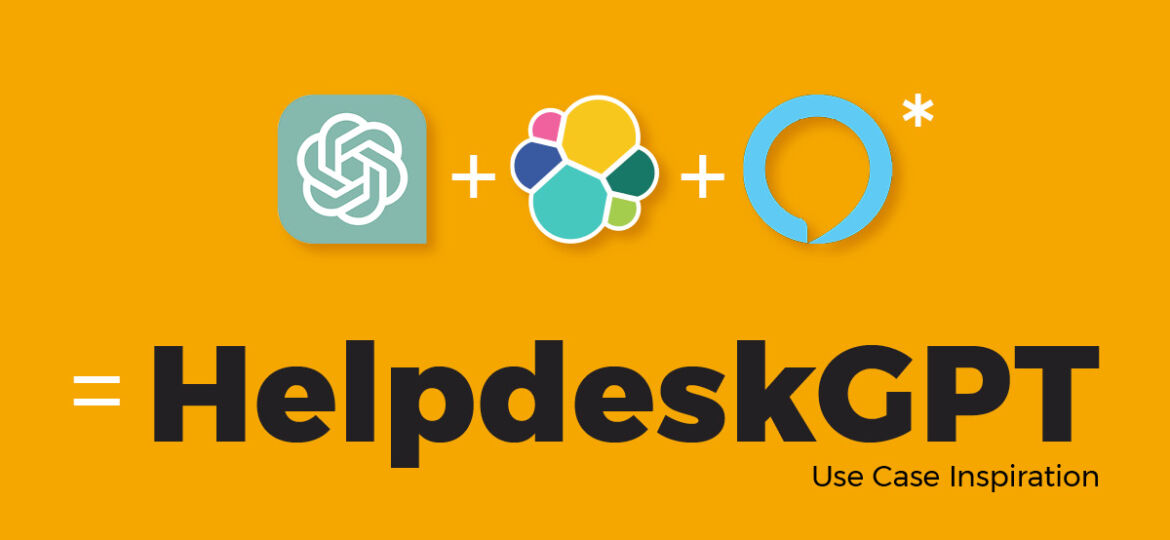Empowering Helpdesk with the powerful combination of the Elastic stack & ChatGPT
The helpdesk industry plays a vital role in ensuring customer satisfaction and resolving technical issues promptly. To improve the efficiency of helpdesk operations, integrating advanced technologies is crucial. One such powerful combination is the integration of Elastic stack with ChatGPT. This fusion of intelligent conversational AI and robust data analytics can revolutionize the helpdesk industry, providing enhanced support and seamless customer experiences. Let's explore the benefits of this integration and highlight specific examples of how it can transform the helpdesk service landscape.

REAL-TIME ISSUE TRACKING & ANALYSIS
By leveraging Elasticsearch, a highly scalable and distributed search and analytics engine, helpdesk systems can capture and index vast amounts of log data, user interactions, and support ticket information.
This real-time indexing enables the system to respond rapidly to user queries and retrieve relevant information efficiently. Elastic Observability further enhances this capability by providing comprehensive insights into system health, performance metrics, and log analysis.
These analytics can assist helpdesk agents in identifying trends, root causes, and patterns, allowing them to proactively address issues before they escalate.
For example, when a customer reports a recurring problem, the integrated system can quickly search through historical data and identify similar cases. Helpdesk agents can use this information to provide more accurate and targeted solutions, which will reduce resolution times, and therefore, increase customer satisfaction.
INTELLIGENT CHATBOT ASSISTANCE
Integrating ChatGPT with Elasticsearch and Elastic Observability empowers helpdesk chatbots to deliver more intelligent and context-aware responses. The integration will be able to understand natural language queries, analyze user intent, and retrieve relevant knowledge base articles, support documents, or troubleshooting guides from the Elasticsearch index.
By combining this capability with the real-time analytics provided by Elastic Observability, chatbots can offer personalized and data-driven assistance to users.
For instance, if a user asks a question about a specific product feature, the chatbot can utilize Elasticsearch to search for relevant articles or Elastic Observability to identify any known issues or recent updates related to that feature.
The chatbot can then provide accurate information or suggest appropriate solutions, reducing the need for human intervention.
BEYOND THE CHATBOT
Imagine the power further integrated with a text-to-speech assistant like Alexa, Siri, or google assistant, as we mentioned in a previous article.
This will give the user a whole new interface to communicate with and give true conversational capabilities.
Examples of use cases are abundant since most helpdesks only work during office hours. A data-driven, conversational, and auditive chatbot can ‘guard’ the remaining 16 hours of the day and night. Afterward, this bot will be able to report and help to sift through what customer tickets have to be prioritized and require human intervention the very next morning.
This will give 24/7 support services possible on smaller budgets.

AI-ASSISTED KNOWLEDGE DATABASE
The combination of Elastic with ChatGPT can help formulate answers – taken from the knowledge base – to customer queries so that the helpdesk operator spends less time researching and keeping the customer on hold or waiting.
It will also vastly improve the quality and speed of new hires to function optimally as a helpdesk agent. Relying on suggested replies, based on the knowledge base of senior helpdesk agents, technical data, or past and resolved issues.
PREDICTIVE ANALYTICS FOR IMPROVED DECISION MAKING
Elastic Observability offers advanced data visualization and analytics capabilities that helpdesk managers and stakeholders can leverage for data-driven decision-making. By monitoring and analyzing various metrics such as response times, ticket volumes, customer satisfaction ratings, and agent performance, the system can identify patterns and trends that enable proactive decision-making.
For example, the integrated system can detect an increasing number of support tickets related to a specific software version or hardware component. Armed with this information, helpdesk managers can allocate resources, plan training sessions for agents, or escalate the issue to the development team for a timely resolution. This proactive approach reduces downtime, improves efficiency, and again, enhances customer satisfaction.
SO WHAT’S IN IT FOR ME?
The integration of Elasticsearch and Elastic Observability with ChatGPT brings countless benefits to the helpdesk industry, revolutionizing the way customer support is delivered. Through real-time issue tracking and analysis, helpdesk systems can proactively identify and resolve problems, resulting in faster response times and increased customer satisfaction.
The intelligent chatbot assistance capabilities provided by combining ChatGPT & Elastic ensure personalized and context-aware support, delivering accurate information and solutions to users.
As technology continues to evolve, the integration of advanced tools like Elasticsearch and Elastic Observability with AI models like ChatGPT will play an increasingly significant role in transforming the helpdesk industry. The future of helpdesk services lies in harnessing the power of intelligent data-driven conversational AI. The integration of the Elastic stack with ChatGPT is a significant leap in that direction.
Contact us



